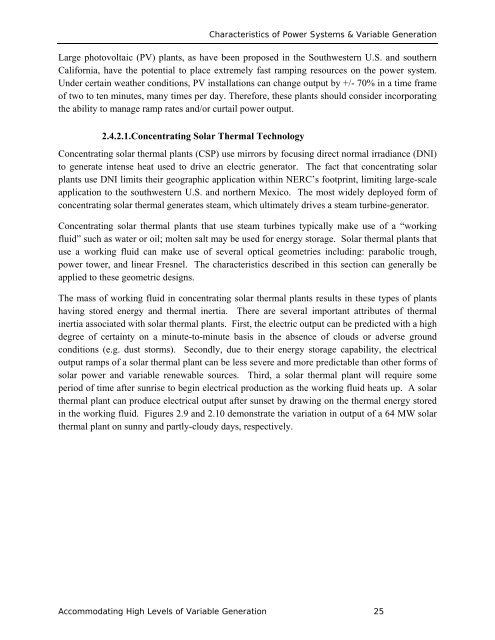Accommodating High Levels of Variable Generation - NERC
Accommodating High Levels of Variable Generation - NERC
Accommodating High Levels of Variable Generation - NERC
Create successful ePaper yourself
Turn your PDF publications into a flip-book with our unique Google optimized e-Paper software.
Characteristics <strong>of</strong> Power Systems & <strong>Variable</strong> <strong>Generation</strong><br />
Large photovoltaic (PV) plants, as have been proposed in the Southwestern U.S. and southern<br />
California, have the potential to place extremely fast ramping resources on the power system.<br />
Under certain weather conditions, PV installations can change output by +/- 70% in a time frame<br />
<strong>of</strong> two to ten minutes, many times per day. Therefore, these plants should consider incorporating<br />
the ability to manage ramp rates and/or curtail power output.<br />
2.4.2.1.Concentrating Solar Thermal Technology<br />
Concentrating solar thermal plants (CSP) use mirrors by focusing direct normal irradiance (DNI)<br />
to generate intense heat used to drive an electric generator. The fact that concentrating solar<br />
plants use DNI limits their geographic application within <strong>NERC</strong>’s footprint, limiting large-scale<br />
application to the southwestern U.S. and northern Mexico. The most widely deployed form <strong>of</strong><br />
concentrating solar thermal generates steam, which ultimately drives a steam turbine-generator.<br />
Concentrating solar thermal plants that use steam turbines typically make use <strong>of</strong> a “working<br />
fluid” such as water or oil; molten salt may be used for energy storage. Solar thermal plants that<br />
use a working fluid can make use <strong>of</strong> several optical geometries including: parabolic trough,<br />
power tower, and linear Fresnel. The characteristics described in this section can generally be<br />
applied to these geometric designs.<br />
The mass <strong>of</strong> working fluid in concentrating solar thermal plants results in these types <strong>of</strong> plants<br />
having stored energy and thermal inertia. There are several important attributes <strong>of</strong> thermal<br />
inertia associated with solar thermal plants. First, the electric output can be predicted with a high<br />
degree <strong>of</strong> certainty on a minute-to-minute basis in the absence <strong>of</strong> clouds or adverse ground<br />
conditions (e.g. dust storms). Secondly, due to their energy storage capability, the electrical<br />
output ramps <strong>of</strong> a solar thermal plant can be less severe and more predictable than other forms <strong>of</strong><br />
solar power and variable renewable sources. Third, a solar thermal plant will require some<br />
period <strong>of</strong> time after sunrise to begin electrical production as the working fluid heats up. A solar<br />
thermal plant can produce electrical output after sunset by drawing on the thermal energy stored<br />
in the working fluid. Figures 2.9 and 2.10 demonstrate the variation in output <strong>of</strong> a 64 MW solar<br />
thermal plant on sunny and partly-cloudy days, respectively.<br />
<strong>Accommodating</strong> <strong>High</strong> <strong>Levels</strong> <strong>of</strong> <strong>Variable</strong> <strong>Generation</strong> 25
















